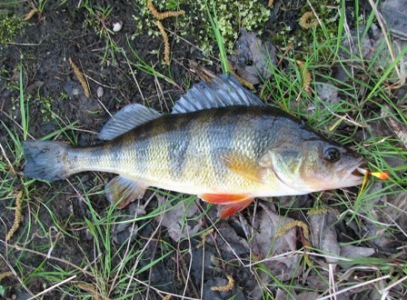
In many areas, fall is one of the best times to fish for yellow perch. These brightly colored fish are hard fighters and make excellent table fare. Although small fish are present during the fall season, trophy class yellow perch are often caught.
For anglers in search of jumbo sized fall yellow perch, location can be a key factor. Large fish are often caught in areas where fishing pressure is light. In many cases, yellow perch hot spots are difficult to reach or present challenges to anglers.
When targeting yellow perch during the fall season, recent information can be extremely valuable. Among the sources are catch reports from bass or crappie specialists. Both of these niche angling groups tend to catch yellow perch by accident while targeting their favorite species. Although some anglers are very tight-lipped when it comes to sharing information, most are more than happy to discuss non-target species.
Structure Fishing
In most locations, fall yellow perch are found near structure. In main rivers, they are often found along steep drops, although perch are quick to move up onto shallow flats to feed during warm periods. During the late season, river anglers sometimes find yellow perch in good numbers, often mixed in with largemouth bass, crappie, white perch, or other species.
In creeks and smaller tributaries, yellow perch move into pools or other deep sanctuaries during the fall season. They often feed aggressively, staging along areas where currents meet eddies.
In small ponds, yellow perch often stage near dropoffs during Autumn. In some impoundments, bass or crappie anglers are sometimes surprised as trophy class yellow perch attack their lures, especially near sunset.
In larger lakes, yellow perch may congregate along slopes or in deep channels near their summer feeding areas. As aquatic vegetation dies off and settles to the bottom, perch may lurk in these deeper areas, feeding on forage fish, insect larvae, crustaceans, and other food sources that are swept into the open.
Lures vs. Baits
When choosing lures or baits for fall yellow perch fishing, anglers take into consideration the type of habitat, water depth, clarity, and temperature, weather conditions, and other factors. Other species may also influence gear choices as some anglers prefer to target yellow perch exclusively, while others may seek a variety of species, including crappie, white perch, white bass, sunfish, largemouth bass, and others.
Best Lures for Catching Yellow Perch
The most common yellow perch lures include a variety of small to mid-sized jigs, spoons, spinnerbaits, crankbaits, tube lures, plastic worms, and other selections. In many environments, the best artificial lures for yellow perch are ones that can reach deep fish while moving enticingly at low speeds. When fish are found among stumps, tree trunks, or other obstructions, snagless designs become essential.
When fishing among obstructions, downsizing of traditional largemouth bass lures and techniques is sometimes effective for yellow perch. Although perch may slow down in cold water, they sometimes bite aggressively and will take plastic worms, tube lures, or other soft plastics.
Live Baits and Rigs for Catching Yellow Perch
In some areas, live baits are preferred for catching yellow perch. Minnows are by far the most common choice as live baits. Alternative live baits sometimes include small crayfish, nightcrawlers, or insect larvae (grubs).
Live minnows can be fished using a number of rigs, with each having one or more specific applications. The simplest rig consists of a basic jig such as a shad dart, tube jig, or marabou jig, tipped with a live minnow. Jig-minnow combinations work particularly well when casting or drifting over shallows or moderate depths.
Minnows can also be fished on a live bait or circle hook, rigged on traditional top and bottom leaders, dropshot rigs, or as Carolina or Texas rigs. Live bait hooks and other traditional style hooks are popular in some applications, although they do have a number of drawbacks.
Floating jig hooks are also useful in some situations, especially when rigged as a Carolina rig. Floating jig heads position live minnows just off the bottom, away from obstructions and other debris.
One option for fishing live minnows is the circle hook. Circle hooks reduce fish mortality by greatly reducing deep hooking. Although circle hooks require a higher level of skill to use than conventional hooks, most anglers find them extremely effective.
Circle hooks are available in a number of styles. Many circle hooks come with offset points, although a true circle hook, by definition, has no hook offset. Most freshwater circle hooks can be easily bent in order to remove any offset, making them less likely to snag on obstructions or gut hook yellow perch.
Circle hooks work well for drifting live minnows on Carolina rigs or on a long leader with a dropper type sinker configuration. Some anglers add a small tube body, bucktail skirt, or mylar skirt above the hook to add elements of flash and color.
Regardless of the type of rig used for catching yellow perch, late season fishing can be productive. Depending on local conditions, yellow perch fishing may continue into winter. In northern areas, more perch fishing follows as soon as lake ice over enough for winter fishing to begin.








































